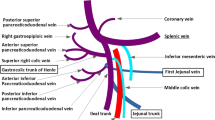Abstract
Purpose
We evaluated anatomical variations of spontaneous splenorenal shunt (SSRS) and the prevalence of portosystemic shunts in patients with chronic liver disease by CT.
Materials and methods
A total of 451 patients with chronic liver disease underwent contrast-enhanced computed tomography between October 2010 and April 2011. The prevalence of portosystemic shunts including SSRS and gastrorenal shunt, and the frequency of hepatic encephalopathy were examined. The course of the shunt and the point of confluence with the renal vein of the SSRS were analyzed.
Results
SSRSs or gastrorenal shunts were found in 11.1 and 5.0% of the patients, respectively. Anatomical variations were classified into three types according to the point of confluence as follows: type 1 = the SSRS joined the inferior phrenic vein (n = 33), type 2 = the SSRS joined the gonadal vein (n = 7), and type 3 = the SSRS joined the left renal vein (n = 14). The course of the SSRS from the splenic hilum was classified as medial (n = 46), posterior (n = 2), or anterolateral (n = 2).
Conclusions
SSRSs were classified into three types depending on the confluence point with the renal vein, and into three types of course. These findings are useful for preoperative information.







Similar content being viewed by others
References
Kanagawa H, Mima S, Kouyama H, et al. Treatment of gastric fundal varices by balloon-occluded retrograde transvenous obliteration. J Gastroenterol Hepatol. 1996;11:51–8.
Hirota S, Matsumoto S, Tomita M, Sako M, Kono M. Retrograde transvenous obliteration of gastric varices. Radiology. 1999;211:349–56.
Kiyosue H, Mori H, Matsumoto S, Yamada Y, Hori Y, Okino Y. Transcatheter obliteration of gastric varices. Part 2. Strategy and techniques based on hemodynamic features. Radiographics. 2003;23:921–37.
Fujimoto M, Moriyasu F, Nada T, Suginoshita Y. Influence of spontaneous portosystemic collateral pathways on portal hemodynamics in living related liver transplantation in children. Transplantation. 1995;60:41–5.
Castillo-Suescun F, Oniscu GC, Hiddalgo E. Hemodynamic consequences of spontaneous splenorenal shunts in deceased donor liver transplantation. Liver Transplant. 2011;17:891–5.
Ruysch F. Curae posteriors, seu thesaurus antomicus omnium praecedentium maximus. Jaussonio-Waesbergios 1738, Amsterdam.
Wind PH, Alves A, Chevallier JM, Gillot C, Sales JP, Sauvanet A, et al. Anatomy of spontaneous and gastrorenal venous anastomoses. Surg Radiol Anat. 1998;20:129–34.
Zardi EM, Uwechie V, Caccavo D, Maira N, Cacciapaglia PF, Matteo FD, et al. Portosystemic shunts in a large cohort of patients with liver cirrhosis: detection rate and clinical relevance. J Gastroenterol. 2009;44:76–83.
Tarantino G, Citro V, Conca P, Riccio A, Tarantino M, Capone D, et al. What are the implications of the spontaneous spleno-renal shunts in liver cirrhosis. BMC Gastroenterol. 2009;9:89–100.
Numata K, Tanaka K, Kiba T, Saito S, Shirato K, Kitamura T, et al. Use of balloon-occluded retrograde transvenous obliteration with etholoamine oleate for the treatment of hepatic encephalopathy in a cirrhotic patient with a large spontaneous splenorenal shunt. J Gastroenerol. 1998;33:424–7.
Takashimizu S, Watanabe N, Kojima S, Kagawa T, Mine T, Myojin K, et al. Efficacy of balloon-occluded retrograde transvenous obliteration performed in a patient with primary biliary cirrhosis with severe recurrent hepatic encephalopathy due to splenorenal shunt. Tokai J Exp Clin Med. 2007;32:70–4.
Rousselot L, Moreno A, Panke W. Studies on portal hypertension. The clinical and physiopathologic significance of self established (nonsurgical) portal systemic venous shunts. Ann Surg. 1959;150:384–412.
Farid N, Balkanci F, Guran S, Senaati S, Besim A. A digital splenoportography: more sensitive method of detecting spontaneous splenorenal shunt. Angiology. 1991;42(9):754–9.
Bagheri M, Haiati A, Hossenini M, Ostad SP. Comparison of findings of spontaneous splenorenal shunt in color Doppler sonography with multislice T scan (64 slices) in liver transplant candidates. Eur J Radiol. 2012;81:2027–36.
Sugano S, Yamazaki Y, Okajima T, Kubo S, Sumino Y, Abei T. Studies on the relationship between hepatic and splenic density change in dynamic CT in the presence of a large splenorenal shunt in patients with liver cirrhosis. Am J Gastroenterol. 1993;88:80–3.
Chikamori F, Okamoto H, Kuniyoshi N. Relationship between splenorenal shunt/portal vein diameter ratio and systemic hemodynamics in patients with liver cirrhosis. Digestion. 2014;89:133–8.
Author information
Authors and Affiliations
Corresponding author
Ethics declarations
Conflict of interest
The authors declare that they have no conflict of interest.
Ethical statement
All procedures performed in studies involving human participants were in accordance with the ethical standards of the institutional and/or national research committee and with the 1964 Helsinki Declaration and its later amendments or comparable ethical standards.
About this article
Cite this article
Achiwa, S., Hirota, S., Kako, Y. et al. Radiological anatomy of spontaneous splenorenal shunts in patients with chronic liver disease. Jpn J Radiol 35, 206–214 (2017). https://doi.org/10.1007/s11604-017-0623-1
Received:
Accepted:
Published:
Issue Date:
DOI: https://doi.org/10.1007/s11604-017-0623-1




